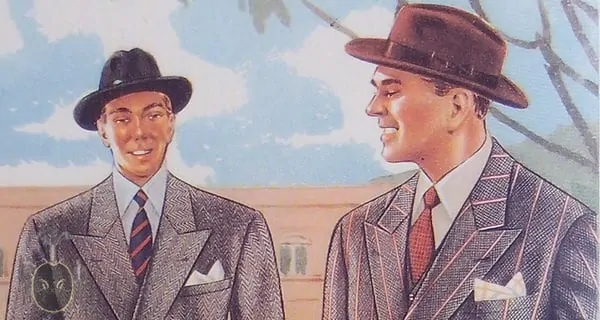When it comes to the high time of classic men’s clothing, many people think first of the 1920’s and 1930’s, as seen in these beautiful fashion illustrations. While this is probably justified, the two following decades are often overlooked. WWII certainly had a huge impact on men’s fashion all over the world. Resources such as fabric became scarce and expensive. Consequently, the full cut trousers with cuffs and double breasted garments with huge overlaps quickly disappeared. Overall, the refined elegance of the 1930’s had to make way for the more practical influences of 1940’s fashion, however, compared to today, it was still very classic and interesting! As such, I would like to introduce some 1940’s men’s fashion using two fashion illustrations from the era.
Kent Fasson Overcoat
First, let’s focus on the gentleman in the center. He wears a beautiful herringbone overcoat in black and white that falls just below the knee. His shoulders are rather wide, though they look more natural and rounder than in the 1930’s. The chest has a little bit of drape, but the bottom half has an interesting flared line. The gorge is rather low, and the lapels have narrowed, relative to the 30’s. The 4×1 position of the buttons is also known as the Kent fasson. It was popularized by the Duke of Kent, though he preferred to wear it on suits, jackets and blazers rather than on overcoats. The jetted pockets are slightly angled, making the wearer look a little more dynamic.
Overcoat with Kent Fasson & Striped Suit
The trousers of his grey suit do have a cuff, but they are cut more tapered and narrow than in the 1930’s. Interestingly, he still uses a walking cane in 1947 ,although the habit of having a cane just for
aesthetics was long out of fashion by then. Paired with understated black shoes, gloves and a Homburg hat, the striped navy-red tie stands out.
Personally, I really like the look of Kent fasson overcoats, although it is not easy to find a nice one these days. For example, I’d prefer one with the top row of buttons set even wider than on this coat.
Bold Striped Suit
The suit on the right is something that you would have found in the late 1940’s and throughout the 1950’s. Everything falls very nicely. Unlike Neapolitan or southern Italian garments, these suits had a fair amount of horsehair canvas in the chest, adding weight and great drape to the garment. Compare the lapels of the jacket to the overcoat, and you will notice the similarities. Of course, the suit lapels are not quite as long, because the jacket is buttoned on the top button.
Nevertheless, the double breasted 4×1 or 4×2 silhouette was quite popular then. The fabrics were also heavier and often times had interesting stripes that are, once again, impossible to find nowadays. I do own a very similar 4×1 suit from the 1950’s in a mid grey herringbone fabric in subtle blue stripes. Although the stripes are not as bold and wide, they are very similar and come roughly from the same time period. Unfortunately, my suit did not come with a vest, although that can be quite warm underneath a double breasted coat.
Once again, the trousers are narrower and feature cuffs, but more importantly the whole look is so different from today’s business suits that you’d really standout out in a combination like that.
While the orange-red tie is fairly standard, the beige color of the shirt is harder to find and infinitely useful. It can be worn with all kinds of brown and grey suits, when white shirts would simply be too formal. So, if you are looking for new shirts – think a about a beige or salmon colored version. Off the rack, they are hard to find, but made-to-measure producers can easily fill the need.
You will probably likewise find the mid-brown derby shoes just as versatile, and even the brown Homburg style hat can be worn on many occasions. If you’re considering getting a hat, try a brown snap brim hat first because you will be able to combine it with many things and it does not look too stiff. Once you are comfortable wearing a hat, you can expand into more formal styles and textures.
Conclusion
Overall, the fashion in the 1940’s was certainly a change from the 1930’s, but the style remained classic, only less exaggerated. Shoulders were more natural, the lapels more subtle and certain silhouettes like the 4×1 grew in popularity. If you have already a couple of suits in your closet, and you are tall and not too portly, you should think about getting a 4×1 suit. They are unique in a non-flashy way, and if you should lose interest in the 4 button look, just have a third row of buttons added on top and it will look like another jacket. You can always sew on extra buttons, but taking them out usually leaves a little hole from the button shank.

Reader Comments
Comments are closed.